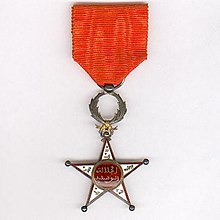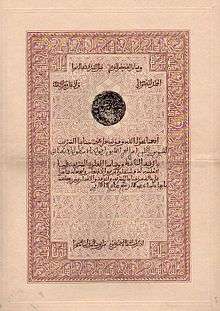Order of Ouissam Alaouite
The Order of Ouissam Alaouite (Arabic: الوسام العلوي الشريف) or the Sharifian Order of Al-Alaoui is a military decoration of Morocco which is bestowed by the King of Morocco upon those civilians and military officers who have displayed heroism in combat or have contributed meritorious service to the Moroccan state. The decoration was established on 11 January 1913 in replacement of the Order of Ouissam Hafidien. It is awarded in five classes: Grand Cordon (Grand cordon), Grand Officer (Grand Officier), Commander (Commandeur), Officer (Officier) and Knight (Chevalier).[1]
| Order of Ouissam Alaouite الوسام العلوي الشريف | |
|---|---|
 Grand Cordon set of the Order | |
| Awarded by | |
| Established | 11 January 1913 |
| Royal house | Alaouite |
| Religious affiliation | Islam |
| Awarded for | Displaying heroism in combat or contributing meritorious service to the Moroccan state |
| Status | Currently constituted |
| Sovereign | King Mohammed VI |
| Grades | Grand Cordon Grand Officer Commander Officer Knight |
| Precedence | |
| Next (higher) | Order of Muhammad |
| Next (lower) | Order of Fidelity |
Ribbon bar of the Order | |
The Order of Ouissam Alaouite is similar to the Legion of Merit, awarded by the United States military.
History

The order of Ouissam Alaouite was created during the colonial period. The French authorities in Morocco considered it necessary to have the power to bestow an official honour or decoration in response to loyal service; and they wanted to avoid over-burdening the bureaucracy of the order of the Légion d'Honneur in Paris.[2] The ribbon of the order during this period was a shade of orange[3] or pumpkin-coloured.[4] In 1934, a white stripe was added on each side of the ribbon.
During the Second World War, the Order of Ouissam Alaouite was bestowed frequently on United States military personnel who had participated in the planning and execution of Operation Torch, the invasion of French Morocco. Morocco was a protectorate of France from 1912 to 1956, and the decoration was bestowed frequently on French military officers during that period.
After Moroccan independence in 1956, the Alawid Order became a prerogative of the Alawid King and his heirs. The Order continues through the present day, the original medal and the 1934's ribbon unchanged.
| Ribbons (1913–1934) | ||||
| Ribbons (1934–present) | ||||
Selected recipients
- Hubert Lyautey – French general (later Marshal of france) ; first French Resident-General in Morocco from 1912 to 1925
- Paul Doury – French general
- Albert I – King of Belgium from 1909 to 1934
- Henry H. "Hap" Arnold – commanding general of the US Army Air Force during World War II
- Inès de Bourgoing – French nurse (and wife of Marshal of France Hubert Lyautey)
- Merieme Chadid – Astronomer and explorer
- Mark W. Clark, Commanding general of the Fifth Army in North Africa and Italy in World War II
- Andrew Cunningham – British admiral, Commander-in-Chief, Mediterranean and later First Sea Lord during the Second World War.[5]
- Dwight D. Eisenhower – U.S. general and later President of the United States
- Jürgen Tönsmann German entrepreneur
- Henri Honoré d'Estienne d'Orves – French resistance fighter
- Alphonse Juin – – French general (later Marshal of France)
- Jean Joseph – French Lieutenant-Colonel (Commander, 19 August 1952)
- Jean Gilles – French general (Grand officier)
- Mohamed Habib Gherab, United Nations Under Secretary-General, Tunisian diplomat and senior government official
- Marie Pierre Koenig – French general (later Marshal of France)
- Jean de Lattre de Tassigny – French general (later Marshal of France)
- Émile-Joseph Duzer – French colonel (Commander, 26 July 1933)
- André Malraux – French author, adventurer and statesman
- George Marshall – U.S. general and later Secretary of State
- Harry McLear – Honorary Consul for The Kingdom of Morocco in Kansas and Missouri
- Raoul Monclar – French general who took a reduction in rank so as to command the French battalion in the Korean War
- George S. Patton – U.S. general[6]
- Saint-Just Pequart – French archaeologist
- René Pleven – French politician
- Arthur Tedder – RAF officer and Deputy Supreme Commander under Eisenhower in World War II, later a Marshal of the Royal Air Force
- Anthony Bailey, Inter-faith campaigner and Chairman of Painting & Patronage
- Wesley Clark – U.S. general
- Ernesto Burzagli, Italian admiral
- Francisco Pérez Pérez, Spanish infantry captain
- John Edwin Bircher III, US Army Colonel and Government Relations Consultant who is the only person to receive two separate awards. The first was Officer Grade by King Hassan II and the second was Commander by King Mohammed VI.
- Georges Journois, French general
- Michel Raingeard – French politician
- Thomas T. Riley – U.S. Ambassador
- Luis Planas Puchades – Spanish politician, Ambassador
- Dominique Strauss-Kahn – French politician, managing director of the International Monetary Fund
- Louis Vannier French air military
- Rachida Dati – French politician, Member of the European Parliament. ex-Minister of Justice
- Jagatjit Singh of Kapurthala – Maharaja of Khapurthala
- Gustave Daladier – French professional soldier and flying ace
- Mohamed El Mansour – Moroccan Professor and Researcher at the University of Mohamed V in Rabat
- Miguel Ángel Moratinos – Spanish diplomat and politician, Minister of Foreign Affairs.
- General Curtis LeMay – Commander of Strategic Air Command
- Brigadier General Elliott Roosevelt – Commander of 3d Reconnaissance Group and subsequent commands, son of FDR
- Khalifa bin Salman Al Khalifa – Prime Minister of Bahrain
- Robert Emmet Rodes III – US Army Lt. Colonel, OSS Section Chief, North Africa; lobbied for fair trade in Morocco during French Protectorate
- Xavier Rolet KBE – CEO London Stock Exchange

- Luis Planas – Spanish politician and ambassador
- Bertrand Piccard – Swiss psychiatrist and balloonist[7]
- Vanessa Branson – 2014, British entrepreneur and founder of Marrakech Biennale
- Charles Tordjman - 2002, Moroccan Dentist.
- Ayoub Qanir – 2015, Film Director
1943 ceremony
In the opening scene of the film Patton, George C. Scott, portraying then-Major General Patton, is shown receiving the Grand Cross of the Order of Ouissam Alaouite. This was no mere Hollywood contrivance. Under Patton's command, Allied forces took Casablanca after only four days of fighting. So impressed was the Sultan of Morocco that he presented Patton with the special Order of Ouissam Alaouite, with the citation: "Les Lions dans leurs tanières tremblent en le voyant approcher" (The lions in their dens tremble at his approach).[6] Patton wryly described the ceremony as a "non-military activity,"[8] but in his memoirs, he does not fail to note the Operation Torch staff officers who were similarly honored on that occasion.[4]
Notes
- Emering, Edward. "Morocco". The Medal Hound. Retrieved 26 September 2013.
- Bidwell, Robin Leonard. Morocco Under Colonial Rule, p. 89.
- Wyllie, Robert E. (1921). Orders, Decorations and Insignia, Military and Civil: With the History and Romance of Their Origin and a Full Description of Each, p. 135.
- Patton, George. (1995), The War as I Knew It, p. 34.
- Cunningham, Andrew Browne. (1951). A Sailor's Odyssey: The Autobiography of Admiral of the Fleet, Viscount Cunningham of Hyndhope, p. 541.
- "Man Under a Star," Time. 29 March 1943.
- "Bertrand Piccard Biography" (PDF). Solar Impulse. Archived from the original (PDF) on 20 January 2013.
- Blumenson, Martin. (1996). The Patton Papers, p. 156.
References
- Bidwell, Robin Leonard. (1973). Morocco Under Colonial Rule: French Administration of Tribal Areas, 1912–1956. London: Routledge. ISBN 978-0-7146-2877-6
- Wyllie, Robert E. (1921). Orders, Decorations and Insignia, Military and Civil: With the History and Romance of Their Origin and a Full Description of Each. New York: G. P. Putnam.
- Rousseau, Pierre. (2005) Ordres et décorations de l'Empire chérifien au temps du Protectorat français au Maroc (1912–1956). Versailles: Mémoire & Documents. ISBN 978-2-914611-30-5; OCLC 60513643
- Décret royal n° 199-66 du 1er ramadan 1386 (14 décembre 1966) portant création des ordres du Royaume – website of the government of Morocco (French)